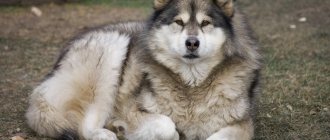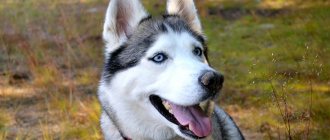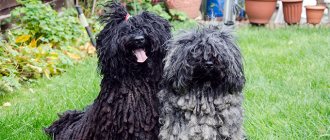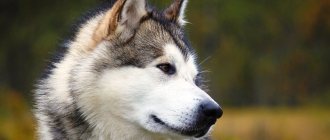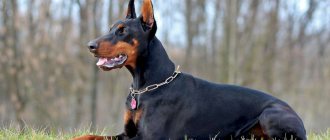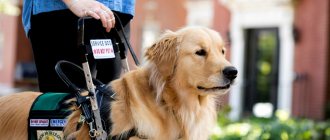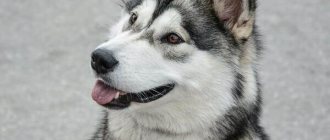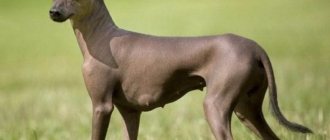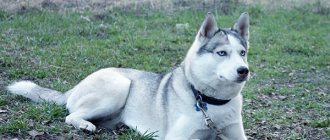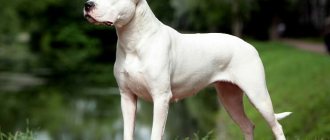Siberian Huskies have long ceased to be just sled dogs. They are distinguished by their calm and calm character, endurance, and kind attitude towards others, which is why dog breeders all over the world adopt charming puppies with blue eyes. Few people know which husky colors correspond to the standard, and which color is classified as a breed defect. Before you buy a cute little cat, it’s worth getting to know the most common color options for its coat.
History of the origin of the husky
The complex and intricate history of the Husky breed still causes controversy among people researching this issue. One thing is known for certain: huskies are the result of crossing northern dogs and wolves. The husky wolf cross was distinguished by its endurance, resistance to severe frosts, loyalty and beautiful appearance.
These wolf dogs turned out to be excellent helpers for residents of the Far North in hunting, reindeer herding and home protection. But the most important duty of the husky, which these dogs have been happily performing for many thousands of years, is transporting a person and his cargo across the vast expanses of the north.
Residents of the nomadic northern tribe - the Chukchi - are considered the founders of this breed. It was these northern people who made their invaluable contribution to the origin of the husky, as they began to use the wolf dog to expand their hunting grounds. For this purpose, the Chukchi needed a dog capable of covering long distances in a short time, while transporting a loaded sleigh. It was this Chukchi pet that became the progenitor of everyone’s favorite Siberian husky.
Eskimos also fell in love with these dogs for their versatility and ease of maintenance. Their dogs had good endurance and could eat dried fish for a long time. There was no shortage of fish, since the northern people caught it in large quantities. By the way, the word “Eskimo” itself, translated from the language of North American and Canadian Indian tribes, means “raw food eater” or “one who eats raw fish.”
Huskies got their name from the abbreviated name “Eski”, which Canadians began to call Eskimos. The name husky was then applied to all sled dogs in the northern region.
How to put ears on a puppy
There are several methods to combat the problem. You can use improvised means or do massages. You can also find special devices on sale.
Changing your diet
The diet helps to improve the ears if the puppy lacks minerals. It is recommended to give your pet cottage cheese to replenish calcium reserves. The introduction of jellied meat into the menu is encouraged. It is made from pig ears. This delicacy contains many substances that are beneficial for cartilage tissue.
Some owners prefer to crush eggshells and add them to food
You can use vitamin-mineral complexes, but before using them you must obtain permission from a veterinarian. The specialist will select the drug and dosage.
Massage
Massage increases blood circulation and promotes the flow of nutrients to the ear cartilage. Usually it is carried out like this: the pet’s ears are lifted and fingers are moved up and down over them. However, there are no strict recommendations on this matter, so you can massage in any way convenient for you and your dog.
Breeds and types of dogs of the north
Basically, all dogs of northern origin are sled dogs that look like a wolf, with a strong build and beautiful coat. There are three main breeds of sled dogs: Husky, Malamute and Samoyed.
Differences between Malamute and Husky breeds
What are the differences between a malamute and a husky, what distinctive features are characteristic of them?
Answering the question of what is the difference between a Malamute and a Husky, it should be noted that Huskies are faster dogs, while Malamutes are strong individuals capable of carrying heavy loads. Representatives of the Husky breed are designed to travel long distances with high speed but light load.
The Alaskan Malamute is a strong dog with a powerful build and well-developed muscles. The Siberian Husky is a fast, agile dog of medium build that maintains a balance of speed and endurance.
The standard height of a husky is 50-56 cm, weight – 16-28 kg. The Malamute reaches a height of 58.5-63.5 cm at the withers, its weight is 34-38 kg.
Siberian huskies are more varied in color than their “Alaskan brother.” “Siberians” can be of almost any color, ranging from black, brown, all the way to snow-white. “Alaskans” can also be different in color, combining gray, black, sable, brown shades, but only white can be an acceptable solid color.
What types of huskies are there?
All huskies are sled breeds, incorporating several varieties of dogs with common characteristics, but different from all other varieties, history of origin, habits and appearance.
Today the husky dog is represented by the following species:
- Alaskan Husky. Bred in Alaska during the Gold Rush, this species is distinguished by its extraordinary endurance and is today used in sled dog competitions.
- Mini Husky or Klee Kai. "Klee-kai" is translated from the Alaskan Eskimo language as "little dog." Mini-husky is no longer a sled dog, but a companion dog, bred for more comfortable keeping of northern breed dogs at home.
- Sakhalin Husky. This type of husky is the pride of Sakhalin; they even erected a monument to it in the south of the island. The Japanese appreciated the qualities of this dog and began breeding this variety in order to save them from extinction. The Sakhalin Husky is a sled dog, but is valued for its courageous character traits, which have earned it a reputation as an excellent military dog.
- Siberian Husky. For several thousand years, the Siberian Husky has served as a sled dog for residents of the northeastern parts of Siberia. The indigenous population, the Chukchi, have long used this species not only for sledding, but also for hunting purposes. The Siberian Husky has long become not only an integral part of the life of this northern people, but is also considered an excellent companion dog, loved by people all over the world.
- The Japanese Husky, a dog bred by the inhabitants of the Land of the Rising Sun, lost its original purpose as a sled dog and became an excellent companion dog.
Saddled (saddleback)
A peculiarity of the color is a peculiar spot in the form of a “saddle” made of darker wool, located on the dog’s back.
Saddled Husky
The main color of the fur coat is white.
Black Husky
The saddle cloth can be any color - from red to black.
Description and characteristics of the Husky breed
Any characteristic of the husky breed begins with a description of the appearance of the northern handsome man. It is not for nothing that these dogs are considered the most beautiful representatives of four-legged animals. Beautiful, moderately fluffy hair of various shades, even, neat triangular-shaped ears, a strong, proportional physique - all this makes the Husky an attractive breed for many dog breeders. In terms of size, the husky is a medium-sized dog: the height of the husky at the withers is about 60 cm, weight – 25-36 kg.
Lifespan of a Husky
One of the frequently asked questions: how long do huskies live, is important when choosing a pet for home keeping. The average life expectancy of dogs of this breed is 12-15 years. But huskies are considered long-lived among dogs; there are cases when some representatives lived up to 20 years. In general, snow dogs are considered long-lived among their relatives. In many ways, the life expectancy of a husky depends on the living conditions, proper nutrition, and sufficient physical activity.
Husky eyes - unusual colors
In addition, it would be impossible to describe the Husky breed without mentioning their unusual eyes. Husky eyes can be gray, blue, or brown, but the most common color of the iris is light blue. Multi-colored eyes are also allowed.
Husky dog coat color - a variety of shades
Characteristics of this breed would be useless without special mention of the color variety of fur color of snow dogs.
Some owners of four-legged pets conduct entire studies to absolutely determine which husky colors are officially recognized not only in Russia, but also abroad.
The following coat colors are considered accepted colors for the Husky breed:
- Solid black.
- Plain white.
- Black and white.
- Grey.
- Silver.
- Ginger.
- Light red.
- Pale yellow.
- Copper.
- Wolf color.
- Sable.
- Agouti.
- Black and tan.
- Piebald.
What does agouti color mean in a husky?
If everything is clear with all the colors listed, then agouti huskies may raise questions among some dog lovers. Agouti-colored huskies are not the best option for shows where the pet's appearance is judged. But such dogs are endowed with excellent hound qualities and are capable of developing great speed, which is why agouti huskies are often used in sled dog sports competitions.
Do colors change with age?
The color of an adult husky is difficult to predict. The fact is that during the first moults (at 6-10 months) juniors “rebloom” and change color. Whether the original color will remain the same, deepen or become more faded is impossible to predict.
For example, a copper puppy may turn red, while a bright red puppy may turn fawn. The “glasses” that give the look charm may also disappear.
Typically, the color of a husky changes slightly with age: the color fades and becomes less saturated.
The character of a husky is a willful, good-natured person.
No description of the Husky dog breed is complete without mentioning their character, which some dog breeders consider complex.
Positive aspects of character
Speaking about the positive qualities of dogs of this breed, one cannot fail to note their friendly disposition and absolute lack of aggression towards humans. Huskies are distinguished by high endurance and well-developed intelligence. They get along well with the whole family, especially children. It is not without reason that the Chukchi have long used huskies to keep newborn children warm.
Negative aspects of character
In addition to the positive aspects, the character of this dog has its drawbacks, the main one of which is considered to be the stubbornness that huskies tend to display, especially during training. Despite the fact that northern four-legged friends are friendly not only to the owner, but also to all the people around him, they will listen and obey exclusively a person with a strong character. It will be difficult for soft and indecisive people to cope with this beautiful obstinate man.
Dogs are runaways
It must be remembered that wolf blood flows in the veins of northern dogs, which at any moment can make itself felt not in the form of aggression, but in hunting instincts, obeying which the dog can “rush” in an unknown direction, pursuing something that interests it object, such as a cat. Very often in such cases the owner forever loses his elite pet of northern blood.
Dogs are fidgety
Huskies are sled dogs that are used to traveling long distances, making it difficult for them to sit still. Before choosing a dog of this breed as a pet, you should think carefully about whether the owner will be able to provide an outlet for irrepressible energy? After all, if a northern friend gets bored, he can turn the whole house upside down.
Absolutely black
Another name for the color is Afrohusky .
Due to genetics, huskies cannot have a blue-black
Black Husky
For a dog to be classified as this color, 75% of its coat must be black.
Photo of a black husky
Moreover, interspersed hairs of a different shade are allowed on the face, tip of the tail and paws.
Howl - the sound signal of a husky
One of the versions of the origin of the name “husky” is from the English word “husky”, which translated means “hoarse, hoarse.” This characterizes either the barking or the growling of a dog. Husky dogs practically do not bark, but you can often hear the characteristic howl of a husky, which causes mixed feelings in its owner.
Why do huskies howl?
For many people, a dog's howling evokes unpleasant emotions, and this is not surprising, since at all times this eerie “dog song” was regarded as an unkind sign. Moreover, the howl of a husky is sometimes so similar to the howls of a wolf, from which one certainly cannot expect anything good.
Why do northern dogs love to howl and growl hoarsely, and not make a loud, ringing bark like all other four-legged friends of man? The answer is quite simple: all huskies are residents of the northernmost parts of the world, where the air temperature sometimes drops below forty degrees. Naturally, barking at such low temperatures is not the most pleasant activity for dogs. In addition, the direct purpose of the husky is to move people and loads in dog sleds. While running, sled dogs spend quite a lot of energy pulling the load, and barking can be an additional burden for the dog while riding in a sled. Therefore, in order to save energy, huskies, tired of running quickly across the cold expanses of the north, prefer not to bark.
Many dog breeders believe that this is the reason why husky dogs communicate in a pack and with humans not by barking, but by howling.
Beautiful Eskimo legend about the husky
In addition to the “official version”, there is a beautiful Eskimo legend that explains this unusual “wolf habit” of huskies. It tells that one day God decided to tell people that death does not exist, and life lasts forever. A cheerful and lively husky got everything mixed up and accidentally distorted the divine message. She addressed people, telling them that death exists, but life cannot be endless. Since then, it has become a custom that husky dogs do not bark when they want to communicate, but emit a melancholy, drawn-out howl.
Howl is an expression of the entire palette of emotions in a northern dog
If huskies howl, this does not mean that they are sad. It’s just that northern dogs express all their emotions this way, including positive ones. The Internet is filled with videos of the “soulful songs” of these cute Eskimo friends. However, if the dog is carried away by his “emotional outpourings” and is disturbing others, it is necessary to stop the “concert on requests”, but not with a sharp ban, but simply switch the pet’s attention to another object that interests him.
Proper pet care
Shedding period and fur
To ensure a comfortable stay, you need to literally know everything about huskies, including the features of grooming . It is thick, soft, and has 2 layers: undercoat and main coat. Molting occurs twice a year; it is, of course, more noticeable in an apartment. It lasts about 3 weeks, and you need to comb it out every 2-3 days with a special bristle brush to remove excess undercoat.
At normal times, it is also worth brushing your dog with such a brush to remove dust and dirt. Since Huskies are a noble breed, their coat is very clean and odorless. There is no need to cut the dog's hair.
Ears, eyes, claws, teeth
To keep your pet healthy, you need to follow some hygiene procedures. One of them is ear cleaning; once every 2-3 weeks it is necessary to examine the ears; it is better to have this done by a veterinarian. In order to clean your ears , you need to:
- Take a cotton swab and soak it in a special purchased solution or oil.
- Lay the dog down in a calm state, secure it firmly.
- Massage your pet's ears to make sure he is comfortable.
- Start cleaning your ears gently from the bottom up, doing it very carefully.
After successful cleaning, you should pamper your pet with something tasty to make it easier for him to cope with stress. The second important element is eye care . To do this, you just need to make sure that there are no purulent discharges, if there are any, carefully remove them with a cotton swab and show the dog to the veterinarian.
Nail care is also important; if the dog is active and walks a lot, then there is no need to trim the nails, since they wear off on the asphalt, but otherwise, you need to contact a veterinarian to sharpen your pet’s claws.
You can do this yourself using a special nail clipper, but it is important to remember that you only need to trim a few millimeters so as not to damage the blood canal, which will be very painful for the dog. It is especially important to monitor the health of your Husky's teeth. To do this, you need to clean it once a week using special products that can be purchased at the pharmacy (brush, paste, nozzle).
In the same group (No. 5 - Spitz) with Husky there are such breeds as Pomeranian Spitz, Akita Inu, Samoyed, and Chow Chow.
Bathing
Huskies should be bathed no more than once a year , using special shampoo and cool water. If the dog lives in an apartment, then shampoo for washing paws should be used extremely rarely, as this harms the husky’s skin.
How long should you walk your husky?
Since Huskies are a very active breed, a daily walk should be 4-5 hours! If you are not willing to devote that much time to this, it is worth finding another breed, as Huskies are very active. In this case, half the time should be spent on active training, games or running, as the dog needs to release all its energy.
Nicknames for huskies
When choosing a name for a husky, it is necessary to take into account the character of the puppy, as well as the northern origin of these dogs.
Her historical homeland, which is characterized by: Blizzard, Blizzard, Winter, Tundra, Fairy Tale, will help you choose a suitable name for a girl’s husky dog. Good nicknames for husky girls: Agatha, Daisy, Becky, Wilma, Gabi, Dixie, Charda, etc.
The following names are suitable for husky boys: Buran, Sever, Nord, Baikal, Boy, Boatswain, Dick, Rem, Sky, Skif, Yantar. Check out the article: What tips should you know when choosing a dog name?
When do puppies' ears stand up?
Let us immediately note that the timing depends on the breed of the pet. For example, huskies and huskies develop ears relatively early: already at one and a half to two months. In Yorkshire Terriers, changes begin after three months. In German Shepherds - at 12–16 weeks. The permissible deviation in both directions is no more than 6 weeks.
Sometimes only one ear goes up; if there is still time left, this is not considered a cause for concern
How much do snow dogs cost?
Many people who have decided on the breed of their future pet may be interested in the question: how much does a husky dog cost, and where can it be purchased? The cost of dogs of this breed depends on many components; the average price of a husky is 18,000-22,000 rubles.
But the value of northern dogs does not depend on how much a husky costs: by purchasing a fluffy puppy, a person finds a devoted friend, a cheerful and cheerful companion with whom you can go on exciting hiking and cycling trips, and maybe even take part in sled dog competitions.
Why don't my puppy's ears go up?
The following factors can slow down or stop the process:
- the pet is not purebred;
- large puppy size;
- weakened immune system;
- period of teeth change;
- stress;
- mineral deficiency.
Even if you bought a puppy with erect ears, they may fall off when moving home. The reason is fear. In an unfamiliar environment, the baby behaves warily. Usually the situation returns to normal after a few weeks.
